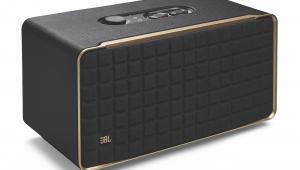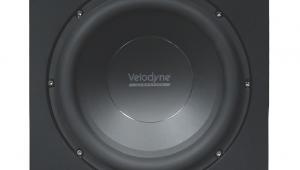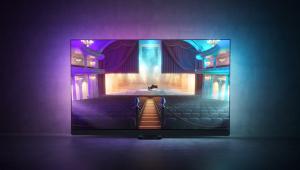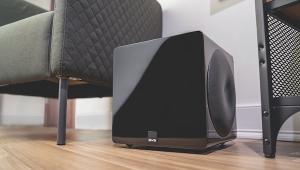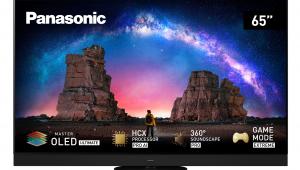Philips 65OLED+936 OLED TV Review Page 2
Panel Beaters
Intriguingly, the OLED+936 features the latest OLED panel from LG Display, and, yes, it's the same construct dubbed Evo by LG, comprising narrower blue and red emission layers, coupled to a new green emission layer. The upshot of this rejigged structure is an increase in brightness, a useful fight-back for OLED against rival LED technology.
The new panel obviously invites comparisons with LG's 'Evo' G1 screen [HCC #320] but in truth, the glass itself isn't the deciding factor when it comes to image quality. Philips' P5 image engine is the MVP here.

The addition of more ambitious AI brings benefits to image sharpness, colour handling and more, and both HDR and SDR content get the deluxe treatment. Japanese period swordplay drama Rurouni Kenshin: The Beginning, a Netflix HD encode, opens with a gore-soaked confrontation in half-light. The OLED+936 presents this with razor clarity and offers plenty of shadow detail regardless. On lesser TVs this might look smeary and dreary, but here it's edge-of-the-seat thrilling.
The depth of this set's colour vibrancy is exhilarating. The anime-style Masters of the Universe: Revelation (Netflix, Dolby Vision) is glorious to behold – you don't even need to venture into Vivid territory to enjoy Eternia's extreme colour pop.
Furthermore, 4K HDR imagery is breathtakingly crisp. Back with the Netflix Formula 1 documentary, the visuals border on three-dimensional, such is the detail, depth and dynamism on display. When cars collide in slow-mo, the cleanly depicted bodywork is mesmerising as it shatters.
(If you want to see exactly what the OLED+936's processing is up to, you can now do that via the TV's revamped AI picture demo mode. The familiar split-screen is out, and in comes a new approach that plays old and new sequentially. It's an interesting look under the hood).
Peak HDR brightness was measured at a touch under 950 nits using a 10 per cent measurement window. This is an excellent performance that puts the OLED+936 on par with Panasonic's JZ2000 [HCC #323], and gives it an edge over LG's G1. The set has the latitude to cover the majority of commercial HDR grading without recourse to tone mapping, taking most HDR content from Netflix and Amazon (amongst others) in its stride.
To better retain detail in fast-moving content, Philips offers a Fast Motion Clarity setting deploying 120Hz Black Frame Insertion. Image smoothness is comparable to 240Hz, but there's a catch. In its lowest setting, the original peak light output of the OLED panel is undimmed, and there's some increase in motion clarity. Move through the gears though, and you'll note a subtle but incremental loss of brightness. The good thing is that there's no pronounced field flicker, which has always made Black Frame Insertion techniques largely unwatchable in the past. That said, given the loss of brightness, keeping to the Minimum setting (or turning the feature off) seems the best option.
Make The Most Of It
Philips' adjustments menus remain labyrinthine and it can take some time to fine-tune images. Experimentation and tinkering is worth the effort, though. For instance, Marvel's Loki (Disney+, Dolby Vision) looks considerably more filmic with Pure Cinema Motion activated, rather than default Standard motion processing. The latter looks a tad sharper but just tends to emphasise the show's ubiquitous green screen VFX.

Disney+ is just one of the streaming services available through the OLED+936's Android TV implementation. This OS is described by Philips as being 'more mature', and it certainly represents an improvement over earlier generations. Slick navigation is bolstered by 3GB of DRAM and 16GB of flash memory.
The provision of Freeview Play (there's also the option of a satellite tuner) ensures all mainstream catch-up TV services are on tap, along with umpteen boxsets. Netflix, Prime Video and Rakuten TV, meanwhile, can be accessed via shortcut buttons on the TV's remote.
Ambilight, of course, is the final given. Presented here in four-sided guise, Philips' built-in mood lighting remains an impressive party trick. Whether you want to sync the light show with a Hue smart lighting system, enjoy kaleidoscopic LED pyrotechnics for gaming, or merely fancy a simple bias light for movie night, Ambilight offers it all.
Sen-Sational!
A nigh-on flawless marriage of image clarity and high-fidelity sound, the OLED+936 can be considered a supremely impressive high-end TV.
Philips' 5th Gen P5 Dual Picture Engine goes hard on image processing, and manages to wow with remarkable consistency. The Bowers & Wilkins sound system is similarly sensational. It's not as overtly immersive as Panasonic's 360 Soundstage Pro system (found on the flagship JZ2000), but then it's taking a different approach, and it sounds superb.
Add Ambilight, next-gen gaming support and a comprehensive smart platform, and you can only conclude this is a race-winning package n
HCC Verdict
Philips 65OLED+936
Price: £3,000
www.philips.co.uk
We say: Beautiful to look at, thrilling to listen to, the OLED+936 is a magnificent marriage of AI image processing and high-end Dolby Atmos audio. A dream screen for movie fans.
Overall: 5/5
Specifications
4K: Yes HDR: Yes. HDR10; Dolby Vision; HDR10+; HLG; HGiG TUNER: Yes. Freeview HD; generic satellite HD CONNECTIONS: 4 x HDMI inputs; 3 x USB; optical digital audio output; Ethernet; headphone output; subwoofer pre-out SOUND (CLAIMED): 70W, 3.1.2-channel BRIGHTNESS (CLAIMED): N/A CONTRAST (claimed): N/A 4K/120 PLAYBACK: Yes DIMENSIONS: 1,227.8(w) x 705.6(h) x 49.3(d)mm WEIGHT: 21kg
FEATURES: 5th Gen P5 AI Dual Engine; Bowers & Wilkins Dolby Atmos sound system; 4-sided Ambilight; Android TV 10 OS; Filmmaker Mode; HDR10+ Adaptive; Fast Motion Clarity; 2 x HDMI v2.1 (48Gbps); ALLM; VRR (including FreeSync Premium Pro and G-Sync); CalMAN Ready; DTS Play-Fi; voice control; Wi-Fi; Bluetooth
 |
Home Cinema Choice #351 is on sale now, featuring: Samsung S95D flagship OLED TV; Ascendo loudspeakers; Pioneer VSA-LX805 AV receiver; UST projector roundup; 2024’s summer movies; Conan 4K; and more
|




















